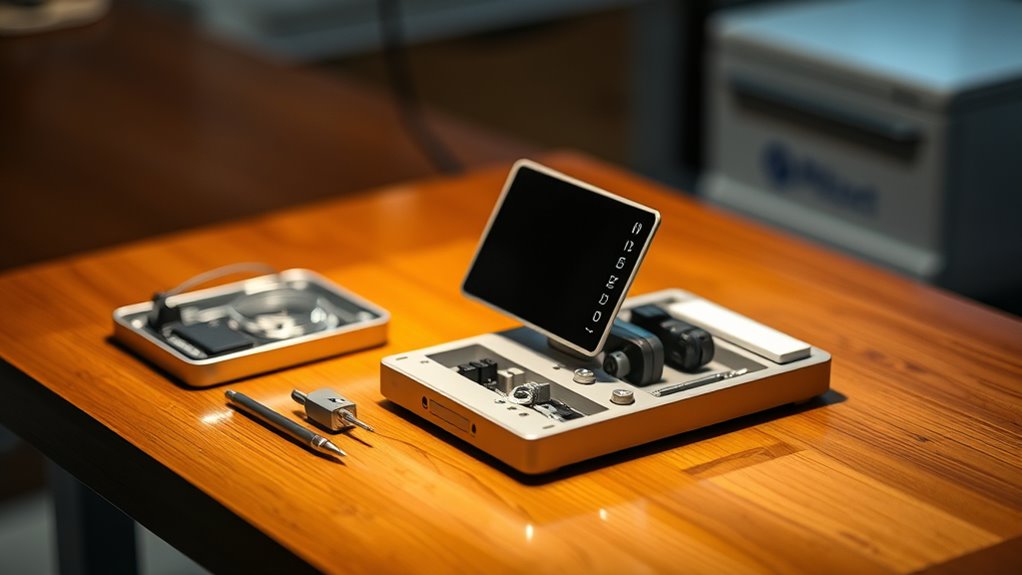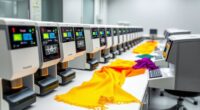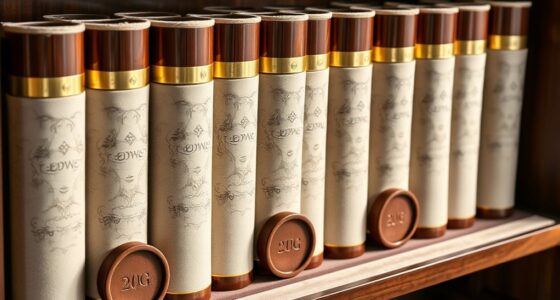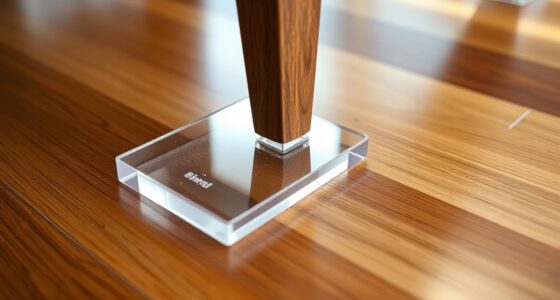Based on my research, the top microfading tester rental kit for art conservation professionals offers high accuracy, sensitivity, and durability, making it ideal for precise damage assessment. It’s user-friendly, portable, and includes solid calibration support to guarantee reliable results over time. Rental terms are transparent, with reasonable costs and ongoing support from providers. If you want to discover which features truly matter and how to choose the best option, keep exploring below.
Key Takeaways
- Ensure the rental kit offers accurate calibration standards and straightforward setup for reliable, sensitive microfading measurements.
- Choose a provider with comprehensive support, including calibration guidance, troubleshooting, and quick training resources.
- Opt for a portable, durable design with high-quality materials suitable for on-site art conservation assessments.
- Verify the kit’s compatibility with your existing documentation systems and its suitability for conservation standards.
- Consider cost-effective rental options that include maintenance, shipping, and insurance, ensuring consistent long-term performance.
Residue Detection Multi-Drug Test Kit – Rapid Surface Residue Detector

The Residue Detection Multi-Drug Test Kit is an excellent choice for professionals and safety-conscious individuals who need quick, reliable surface residue detection. I’ve found it to be discreet, easy to use, and highly effective at identifying trace or bulk drug residues on surfaces. Its sealed system eliminates contamination risks, and no special training or equipment is required. The straightforward testing process involves swabbing, crushing ampoules, and reading results in under a minute. Plus, the option to scan a QR code for automated detection adds convenience. Overall, it’s a portable, trustworthy tool for maintaining safety in various environments.
Best For: safety-conscious professionals, educators, and individuals who need quick, reliable surface drug residue detection in various environments.
Pros:
- Fast results within 30-60 seconds, enabling quick decision-making
- Discreet, portable design ideal for on-the-go testing in multiple settings
- Sealed system prevents contamination and ensures sample integrity
Cons:
- Proper technique is essential; mishandling can lead to inaccurate results or splatter
- Some users may experience issues with QR code scanning or damaged ampoules upon arrival
- Multiple kits may be necessary for thorough testing due to potential damage or defective units
Factors to Consider When Choosing a Microfading Tester Rental Kit Online
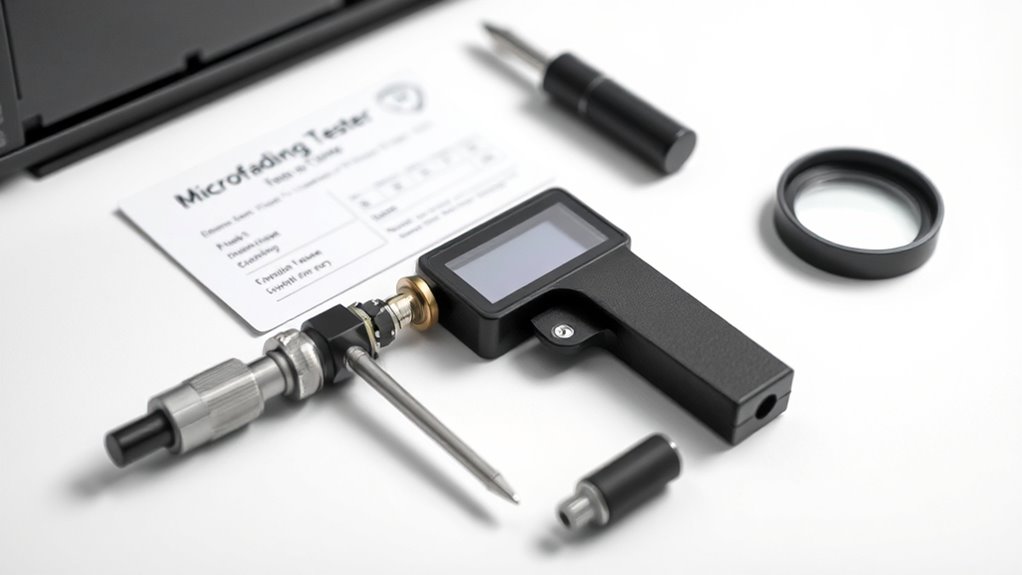
When selecting a microfading tester rental kit online, I focus on device accuracy and sensitivity to make certain of reliable results. I also consider rental costs, terms, and how easy the device is to operate for my projects. Finally, I check if the kit is compatible with my work and easy to calibrate and maintain.
Device Accuracy and Sensitivity
Selecting a microfading tester rental kit online requires careful attention to its accuracy and sensitivity, as these factors directly impact the reliability of your conservation assessments. Accuracy depends on well-calibrated light sources and sensors, ensuring consistent, trustworthy measurements. Regular calibration is essential to maintain this precision. Sensitivity determines how well the device detects small changes in color or fading, which is vital for evaluating delicate or aged materials. Higher sensitivity enables earlier detection of deterioration but might increase false positives if not properly calibrated. The ability to adjust sensitivity levels allows for tailored assessments across different sample types. Consistent and validated sensitivity testing builds confidence in the data, ensuring your conservation decisions are based on dependable, accurate information.
Rental Terms and Cost
Evaluating rental terms and costs helps make certain you choose a microfading tester rental kit that fits your project’s needs and budget. I start by reviewing the rental agreement carefully, noting the duration, renewal options, and return policies to avoid surprises. Comparing prices across providers is essential, especially when factoring in additional fees like security deposits, shipping, and insurance. I also check if maintenance or calibration is included, ensuring accuracy throughout the rental period. It’s important to understand any usage, storage, or handling limitations to prevent extra charges or damage penalties. Finally, I weigh the total cost of renting versus buying, considering how often I’ll need the device for long-term projects. This approach helps me select the most cost-effective and practical option.
Ease of Use
Choosing a microfading tester rental kit that’s easy to use can considerably streamline your conservation work. Look for a kit with a straightforward setup that requires minimal calibration, so you can start testing quickly. Clear, step-by-step instructions and visual guides help guarantee proper operation without extensive training. A compact, portable design makes it easy to handle and use in different environments, saving you time and effort. User-friendly interfaces, such as simple controls or automated features, reduce the chance of errors and improve efficiency. Additionally, quick result reading—typically within minutes—allows you to assess artwork rapidly, even with limited technical expertise. An intuitive, hassle-free kit helps you focus on your conservation projects without unnecessary complications or delays.
Compatibility With Projects
When evaluating a microfading tester rental kit for your project, it’s essential to guarantee it’s compatible with the specific materials and artifacts you’ll analyze. Check that the kit’s wavelength range and light intensity match the sensitivity requirements of your substrates, such as paper, textiles, or photographs. Make sure it includes the necessary accessories or adapters for different sample sizes or formats. Compatibility with your existing documentation system is also critical; verify that the software or data output formats integrate seamlessly. Additionally, review the rental terms to confirm the kit’s suitability for your environmental conditions and conservation standards. These considerations help guarantee the tester will perform accurately and efficiently within your project’s unique parameters.
Calibration and Maintenance
Ensuring accurate and consistent results from a microfading tester rental kit depends heavily on proper calibration and ongoing maintenance. I look for kits that provide clear instructions for calibration procedures to ensure measurement precision. It’s important to verify if the kit requires periodic calibration and whether calibration tools or standards are included or need to be purchased separately. I also check the manufacturer’s guidelines for recommended maintenance routines to prevent sensor degradation and sustain performance. Knowing if the rental service offers calibration and maintenance support is a plus, but I understand that sometimes these responsibilities fall on me. Ultimately, I consider the availability of calibration records and their traceability, which are essential for quality assurance and adherence to preservation standards.
Support and Training
Support and training are vital factors to contemplate when selecting a microfading tester rental kit online, as they directly impact the accuracy and efficiency of your work. Reliable support ensures you can troubleshoot issues quickly, minimizing downtime during testing. Well-designed training materials like tutorials, manuals, or online courses help you understand proper handling, calibration, and interpretation of results, reducing errors. Responsive customer service is indispensable for resolving technical questions promptly, keeping your work on track. Some rental providers offer on-site or virtual training sessions to ensure you’re confident in using the equipment correctly. Clear guidance on safety precautions and maintenance further enhances the reliability of your testing outcomes, making support and training key components of a successful rental experience.
Portability and Storage
Choosing a microfading tester rental kit with portability and storage in mind is essential for efficient fieldwork and on-site testing. A lightweight, compact design makes transportation easier and allows quick setup and breakdown, saving valuable time. A durable storage case is crucial to protect sensitive components during transit and storage, preventing damage and ensuring longevity. Inside the case, organized compartments help keep all parts secure and accessible, streamlining your workflow. Additionally, consider the kit’s power source—battery life or portable power options are vital for remote locations without electrical outlets. Overall, a well-designed portable kit enhances your flexibility, reduces logistical hassle, and guarantees your equipment stays safe and ready for use whenever you need it.
Reliability and Durability
When selecting a microfading tester rental kit, prioritizing reliability and durability helps guarantee consistent performance throughout its use. I look for kits made from sturdy materials that can handle repeated handling and transportation without degradation. High-quality, stable components—like reliable light sources and sensitive detectors—are essential for producing accurate, reproducible results over time. Durability also means resistance to environmental factors like dust, moisture, and temperature fluctuations, which could impair device function. A well-designed kit includes robust calibration features or simple procedures to keep measurements precise during multiple uses. The overall build quality and choice of materials directly influence the device’s longevity and consistent performance, ensuring I get reliable results throughout my conservation projects.
Frequently Asked Questions
How Often Should I Calibrate the Microfading Tester?
You’re wondering how often to calibrate your microfading tester. I recommend calibrating it at least once every six months to guarantee accuracy, especially if you use it frequently or in varying conditions. If you notice any inconsistencies or after a significant impact or storage change, calibrate immediately. Regular calibration helps maintain reliable results, which is vital for making informed conservation decisions.
Can Rental Kits Be Customized for Specific Conservation Needs?
Imagine you’re working on a delicate painting, and you need a microfading tester tailored to its specific materials. Rental kits can indeed be customized for your conservation needs. I’ve seen professionals request specialized filters or calibration settings for unique pigments or varnishes. By communicating your project details, you can get a kit that’s perfectly suited, ensuring accurate results and better preservation outcomes.
What Is the Typical Lifespan of a Rental Microfading Tester?
The typical lifespan of a rental microfading tester usually ranges from several months to a year, depending on usage and maintenance. I recommend regularly calibrating and caring for the device to guarantee accurate results throughout its rental period. When returned, proper inspection and servicing can extend its usability for future rentals. If you need it for a long-term project, inquire about extended rental options or maintenance plans.
Are There Training Resources Included With the Rental Kit?
Ever wonder if you’ll get the training you need? With this rental kit, I was pleasantly surprised—training resources are included! They walk you through setup, calibration, and proper use, making it easy even if you’re new to microfading testing. This guidance guarantees you get accurate results and feel confident in your work. It’s like having an expert right there with you, step by step.
How Do I Troubleshoot Common Issues With the Device?
When troubleshooting your device, I recommend first checking the user manual for specific guidance on common issues. Make sure the power source is stable and connections are secure. If the device isn’t responding, try restarting it or resetting to factory settings. For persistent problems, contact customer support. I’ve found that routine calibration and proper handling usually resolve most issues quickly, keeping your work smooth and efficient.
Conclusion
Did you know that over 70% of art conservators prefer renting microfading testers for their flexibility and cost savings? Choosing the right rental kit guarantees precise, reliable results without the hefty investment. By considering factors like device sensitivity and ease of use, you can protect priceless artworks effectively. Renting not only saves money but also keeps you up-to-date with the latest technology. So, make an informed choice and elevate your conservation work today!
